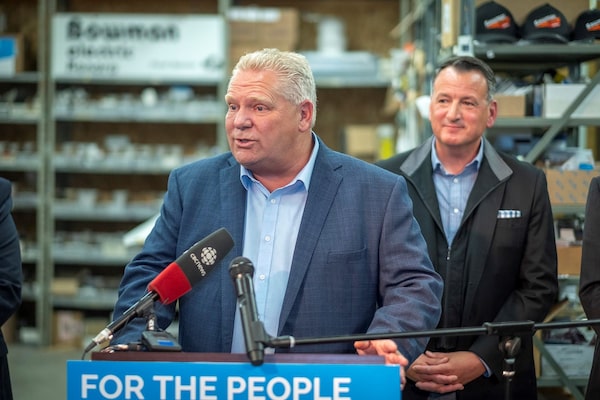
Mr. Ford made the bombshell announcement that the province was halving the number of Toronto’s wards in the middle of the subsequent municipal election campaign in late July, 2018.Tom Thomson/The Canadian Press
Ontario government bureaucrats began working on reducing the size of Toronto City Council less than 24 hours after Premier Doug Ford won the provincial election last year, despite his Progressive Conservative Party not raising the idea during the campaign.
Documents obtained by The Globe and Mail reveal that bureaucrats quickly started researching cutting the number of Toronto city councillors – timing that suggests the move was an undisclosed top priority for the newly elected Premier.
Mr. Ford made the bombshell announcement that the province was halving the number of Toronto’s wards in the middle of the subsequent municipal election campaign in late July, 2018. Toronto launched a legal challenge, which it lost on appeal last month but plans to ask the Supreme Court of Canada for permission to appeal the decision.
Don Peat, a spokesman for Mayor John Tory, said the mayor continues to oppose the provincial government’s actions, calling them "unfair, unnecessary and unprecedented.”
Julie O’Driscoll, a spokeswoman for Municipal Affairs and Housing Minister Steve Clark, did not address questions related to the timing of work to cut Toronto city council.
“We were elected on a promise to reduce the size and cost of government and to end the culture of waste and mismanagement; we acted quickly to do just that,” Ms. O’Driscoll said in an e-mail.
On the morning after the election, Mr. Ford announced that his transition team had “already hit the ground running as we prepare to form government.” The government was officially sworn in three weeks later.
Mr. Ford’s surprise move to cut Toronto city council to 25 wards from the planned 47, which was not part of the PCs’ election platform and did not come up on the campaign trail, was widely criticized as overstepping. Mr. Ford, a one-term former Toronto city councillor who has railed about political gridlock at city hall, lost the 2014 mayoral race to Mr. Tory.
"I think this timing only reinforces the fact that the move to slash city council in half in the middle of an election was a political decision,” said Michal Hay, executive director of Progress Toronto, an activist group.
An Ontario Superior Court judge ruled that the government’s intervention was unconstitutional in September, 2018, but the Court of Appeal granted the province’s request to put the ruling on hold pending a final decision. The municipal election proceeded with Mr. Ford’s 25-ward map last October.
E-mails and other documents, which were released under the province’s freedom of information law, show that senior bureaucrats in the Ministry of Municipal Affairs and Housing began researching issues related to the size of Toronto city council in the afternoon of Friday, June 8, 2018.
The first e-mail in the documents obtained by The Globe was sent at 4:45 p.m., when Anna Hodgins, executive assistant to Kate Manson-Smith, assistant deputy minister of the local government and planning policy division, e-mailed her boss a map of Toronto divided into 26 wards. A couple of hours later, another bureaucrat sent colleagues a 2017 Ontario Municipal Board decision on appeals to the city’s plan to have 47 wards in the October, 2018, municipal election.
Just before midnight, deputy minister Laurie LeBlanc e-mailed Ms. Manson-Smith a 2016 poll on ward boundaries.
Early the next morning, June 9, Ms. Hodgins e-mailed a colleague a summary of the city’s previous ward boundary review, which noted that the consultant in charge concluded that creating 25 wards to match federal and provincial riding boundaries led to “challenges in achieving voter parity (an identified component of effective representation)” and “there was little support for this option at public meetings.” She also sent comparisons of council sizes in other cities in Ontario and across Canada.
On June 12, Ms. Manson-Smith asked colleagues to create a map overlaying provincial electoral boundaries on Toronto’s planned 47 wards, requesting it be done in under an hour as a “top priority.”
The e-mail traffic appears to stop in late June after a “Toronto council study binder” was created for the deputy minister’s office for June 29, the day the Ford government was sworn in. The documents are partly redacted under Freedom of Information Act exemptions for advice to government and solicitor-client privilege.
One month later, on July 22, bureaucrats shared a link to a column by Sue-Ann Levy in that day’s Toronto Sun urging Mr. Ford to cut Toronto city council in half.
That evening, Ms. Manson-Smith sent an urgent e-mail tasking colleagues with working on materials related to cancelling elections for heads of regional governments.
Later that week, Mr. Ford announced the government would reduce the size of Toronto City Council and cancel regional chair elections in Peel, York, Niagara and Muskoka.
Our Morning Update and Evening Update newsletters are written by Globe editors, giving you a concise summary of the day’s most important headlines. Sign up today.
 Jill Mahoney
Jill Mahoney